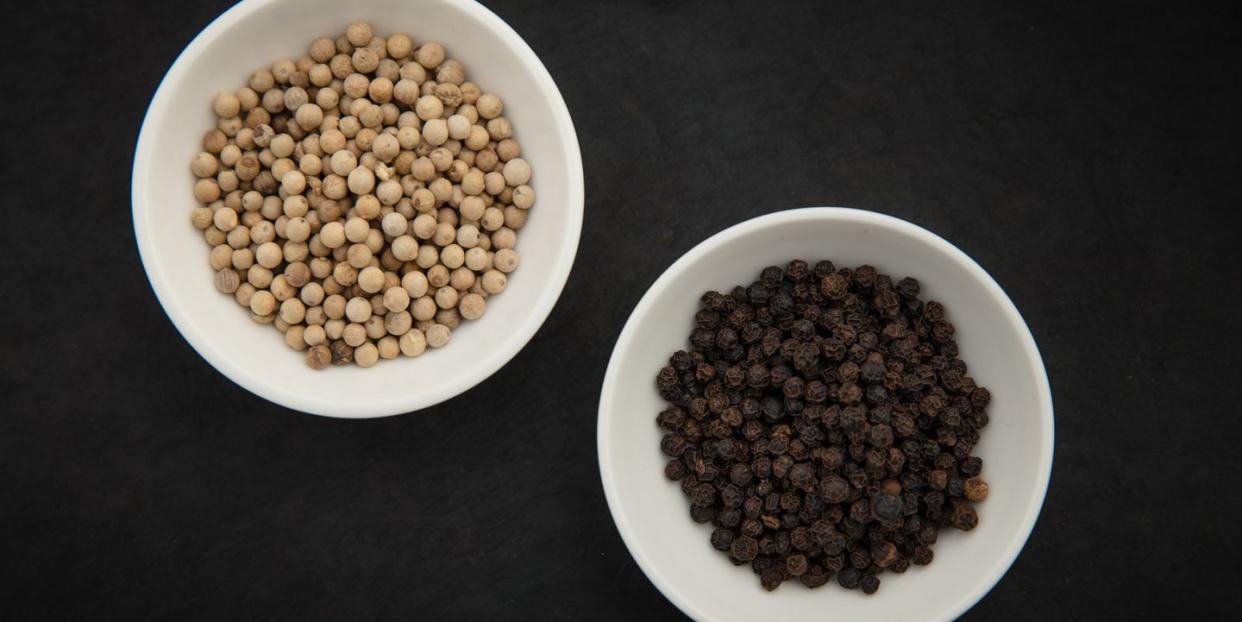White Pepper vs Black Pepper: What's the Difference?

Have you ever noticed that some recipes (like Ree Drummond's pepper-parmesan biscuits and lemon-pepper grilled rib-eyes) call for black pepper, while others (like this white chicken chili) specify that you should use white pepper? Pepper is the most widely consumed spice in the world and a central ingredient in many different cuisines, but not all peppers are the same. In the case of white pepper vs. black pepper, one isn't universally better than the other: The type of pepper you use really just depends on the flavor profile of the dish, the amount of pepper you're using, and even the final appearance you want to achieve.
Both white and black peppercorns are actually small dried berries from the same pepper plant (Piper nigrum), which is native to India. The difference between white pepper and black pepper has to do with when the berries are harvested and how they are processed. These two processes result in peppercorns that not only look different but also have distinct flavor profiles.
Wondering when to use white pepper vs. black pepper in your cooking? Keep reading for a closer look at the differences between these two types of peppercorns and some common uses for each.
What is white pepper, and how is it different from black pepper?
The berries used to make black pepper are harvested before they are ripe. These unripe green berries are cooked and dried, which causes the skin to blacken and become wrinkly. White pepper, on the other hand, is made from fully ripened berries. The ripe berries are soaked and fermented in water, removing the outer skin. Only the inner seed is dried.
Freshly ground black pepper is often described as hot, floral, and pungent. White pepper has a less pungent heat due to the chemicals that are stripped away when the skin is removed. At the same time, allowing the berries to fully ripen and ferment results in white pepper's more complex, earthy flavor.
White and black pepper can be purchased in two forms: whole peppercorns or ground. Buying whole peppercorns and grinding them yourself will give you the best flavor, but pre-ground pepper is is nice to have on hand because it's quick and easy to measure. Consider buying pre-ground pepper in smaller quantities, as it begins to lose its flavor after a few months. Whole peppercorns, on the other hand, will generally retain their flavor for a year or more.
When should you use white pepper?
White pepper is a key ingredient in Chinese cuisine and much more common than black pepper, according to The Woks of Life. Use it in soups (such as hot and sour soup), sauces, stir-fries, and more for authentic flavor. White pepper is also common in Thai dishes.
You can use white pepper in light-colored dishes to avoid dark speckles, too. In classic French cooking, for example, white pepper is used to season creamy béchamel sauces and soups like Vichyssoise without affecting their appearance. Swedish meatballs call for white pepper for the same reason.
Can you substitute black pepper for white pepper and vice versa?
If the amount of pepper you're using is very small, you can usually swap white pepper for black pepper and vice versa without a noticeable difference. But for recipes that rely heavily on one or the other, you'll want to stick with the type that's specified to achieve the correct flavor. Likewise, if you're making a light-colored dish that typically calls for white pepper for aesthetic reasons, keep in mind that substituting black pepper will change the final look.

